Written by Matt Dickinson
14th October 2020
Climb Mont Blanc, Mont Blanc Climber, Gouter Route, Gran Paradiso altitude training
IFMGA Guide Matt Dickinson answers your questions!
Matt has over 50 ascents of the mountain to his credit; here he fields some of the frequently asked questions regarding this popular mountaineering challenge.
Why climb Mont Blanc?
The principal reason is that it’s the highest in the Alps and in Western Europe. But aside from that it is fantastically wild and spectacular, definitely a mountaineer’s peak rather than a trekking peak. The mountain is a colossal white dome surrounded on all sides by thundering glaciers, huge alpine faces and elegant granite spires. Especially for those without a lot of mountaineering experience, an ascent of the mountain shows us a wonderland that far surpasses expectations.
How busy is the mountain on a good day?
On a good day in the summer, it’s very busy and it’s likely that north of 200 climbers will reach the summit. In mediocre weather and out of season the mountain can be very quite. When the weather is bad, there is nobody! Unless camping, all summiteers need to use one of the huts on the mountain for one or two nights; this restricts the amount of people that can be on the mountain at any one time. It’s worth remembering however that the mountain is a vast place, and even on a busy day there is plenty of room to spread out.
There are a lot of reported accidents on Mont Blanc, what are the risks?
There are risks which have to by accepted by all climbers. The risks are from falling snow and stones, altitude, cold weather and wind. We can never guarantee anybody’s complete safety in the mountains, however, we can say that joining a professionally guided group is the safety way to attempt the mountain and gives the greatest chance of success. Most of the principal risks are easily negated by using the correct techniques and using a guide with a thorough knowledge of the mountain.
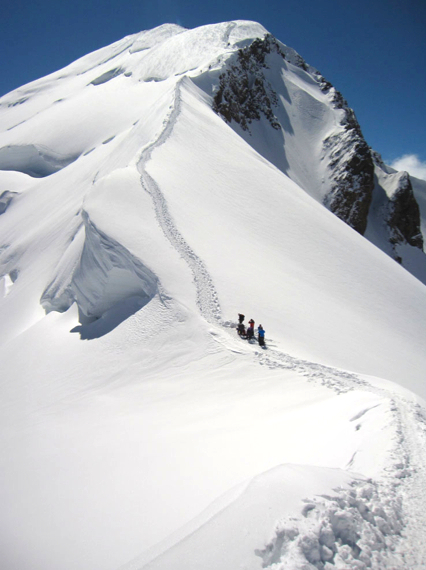
When is the best time to climb Mont Blanc?
Many people ask this question, but the fact is there is not a best time. It’s all dependent on prevailing weather and conditions. Most ascents take place in the summer months, between June and September (inclusive); this is when the huts are open. However it is possible to climb the peak outside these months, especially during long settled weather periods when the wind speed is low. Very few people climb the peak in winter, it’s simply too cold. I often advise people to climb the peak in early September, its quieter than August and there are less afternoon storms.
Is it possible to climb Mont Blanc without any mountaineering experience?
Yes and many people do, but only with a guide. There are a lot of accidents on Mont Blanc; this is no place for the unguided hill walker. Previous mountaineering experience is always preferred. For example the Scottish winter hills provide an excellent training ground. If you want to attempt the mountain without previous experience, I suggest supplementing your chances with a rigorous fitness program before the trip.
What are my chances of success?
Overall, 60% of our guests summit on Mont Blanc, however weather has more to do with this than individual fitness. In good weather and conditions, a fit climber or walker has 80% chance of reaching the summit.
How dangerous is the ‘Grand Couloir’?
Often the couloir is safe; all the rocks remain safely glued in place. Sometimes, practically during hot weather the couloir is loose and represents an accident waiting to happen. Your guide will make the judgment weather the couloir is safe enough to cross and how to cross it.
What alternatives are there to the Gouter route?
The second most popular route is the ‘Three Monts’ route it is a magnificent traverse entirely on glaciers. It begins from the Cosmiques refuge which is accessed via the high Aiguille du Midi cable car. The route is shorter than the Gouter route and technically more difficult. There are less escape options once high on the mountain so we only recommend this climb for more experienced mountaineers. It is also possible to attempt the ‘Pope Route’ from Italy; this is a technically straightforward route but longer and consequently more strenuous than the routes on the French side.
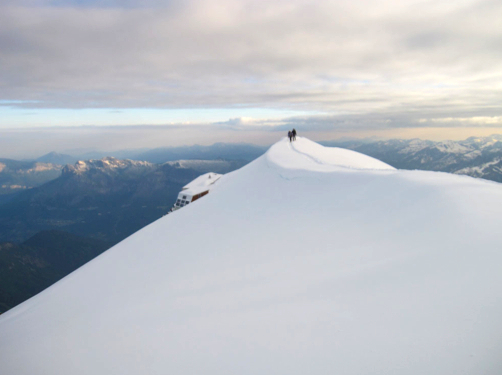
Above the Gouter Hut on a snowy day
How good are the huts on Mont Blanc?
The huts have been hugely improved over the years, and generally people are surprised how good they are. A bunk and a hearty evening meal and breakfast are supplied for everybody. The downside is the huts are always very busy.
Do I need to buy a lot of expensive mountaineering gear?
You will need to be well equipped with mountaineering hardware and good quality warm clothing. All equipment can be hired locally if you don’t want to buy.
How do I increase my chances of success?
A serious commitment to fitness is the best way; this should start long before your trip. Sustained aerobic training is the best, so the usual suspects: running, cycling hill walking are excellent. Try to do your training outside as apposed to a gym. Personally I think strenuous hill walking with a rucksack (all day) is the most effective, go hard on the uphill, this will pay off later on Mont Blanc.
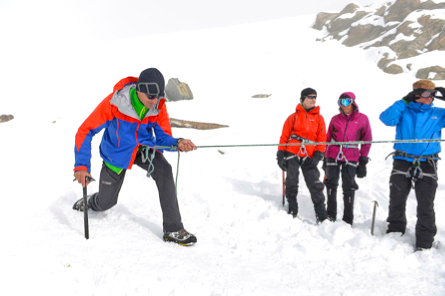
Training for the ascent
What happens when the mountain is out of condition?
In this situation we have little choice but to find another suitable objective in a place where the weather and conditions are better. Often we climb Grand Paradiso (4061m) in Italy or Monte Rosa the second highest mountain in the Alps in Switzerland. As mountain guides, we aim to give the best possible mountain experience, whatever the prevailing conditions.
Please describe the Gouter route, stage by stage...
The Gouter route is the easiest and most popular route up Mont Blanc. The first 1300m are achieved by train! We take the Tramway du Mont Blanc to the end of the line: Nid d’Aigle at 2372m. From here we begin a steep trail walk to the Plateaux des Rognes (1hr), this is a good place to take a break and enjoy being up high. From here the path gets gradually steeper and more exposed as it climbs up the ridge dropping down from the Aiguille du Gouter. Eventually, we gain sight of the Tete Rousse Refuge, the first hut on Mont Blanc. From the Tete Rousse, the hill walking ends and the Mountaineering starts. After crossing the small Tete Rousse glacier the Gouter ridge begins in earnest, but first, we must cross the infamous ‘Grand Couloir’. This is basically a huge scree slope which narrows at the bottom thus funnelling any falling stones; of course we cross this section with haste and care. Once over the couloir we scramble up the long ridge to the Gouter hut. There is a well-worn trail here with some fixed cables for assistance, sometimes crampons are worn, sometimes not depending on the snow. The scramble is not as difficult as it first appears, but does require sure-footedness and use of hand holds. The ridge tops out on a long flat ridge the Aiguille du Gouter (3800m) 3 hours from the Tete Rousse.
The incredible new Gouter hut lies on this ridge, where it is likely we stay the night. After an early (and cold) start in the morning, we walk easily, first flat, then steepening up the north-west face of the Dome du Gouter. We don’t summit on the Dome, instead we pass over the left shoulder and make our way gently down hill, then back up again to the Vallot hut (4360m) which is an emergency bivouac shelter. We are now standing directly below the Bosses Ridge which leads directly to the summit. The ridge starts with a short, steep snow slope leading to two distinctive bumps of snow (thus the name ‘Bosses’ Ridge). We pass the Bosses using careful crampon work and follow the exposed snow ridge to the summit. 5 – 6 hours from the Gouter hut.
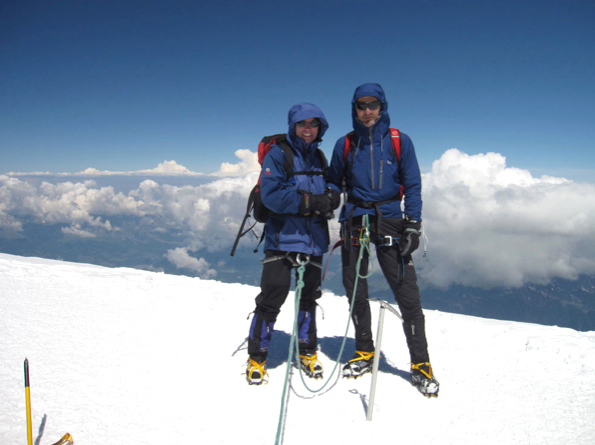
Summit
How many days does it take to climb Mont Blanc?
All our Mont Blanc courses are 6 days long. The first three days are spent training and acclimatising in preparation for the ascent. The next three days are spent ascending and ascending Mont Blanc. In all, 4 nights are spent in mountain huts; other nights are spent in valley accommodation.
If you are interested in Climbing Mont Blanc with the experienced team at Mountain Tracks contact or check out the trip page: Climb Mont Blanc.
Matt
 Off-Piste
Off-Piste Ski Touring
Ski Touring Via Ferrata
Via Ferrata Ice Climbing
Ice Climbing Alpine Glacier Trekking
Alpine Glacier Trekking Worldwide Trekking
Worldwide Trekking



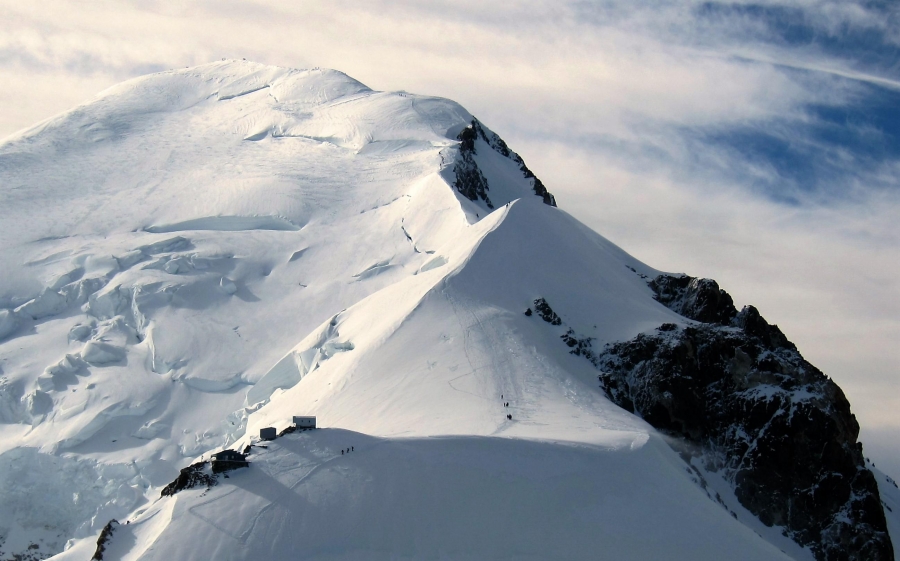




 Travel Website Development
Travel Website Development